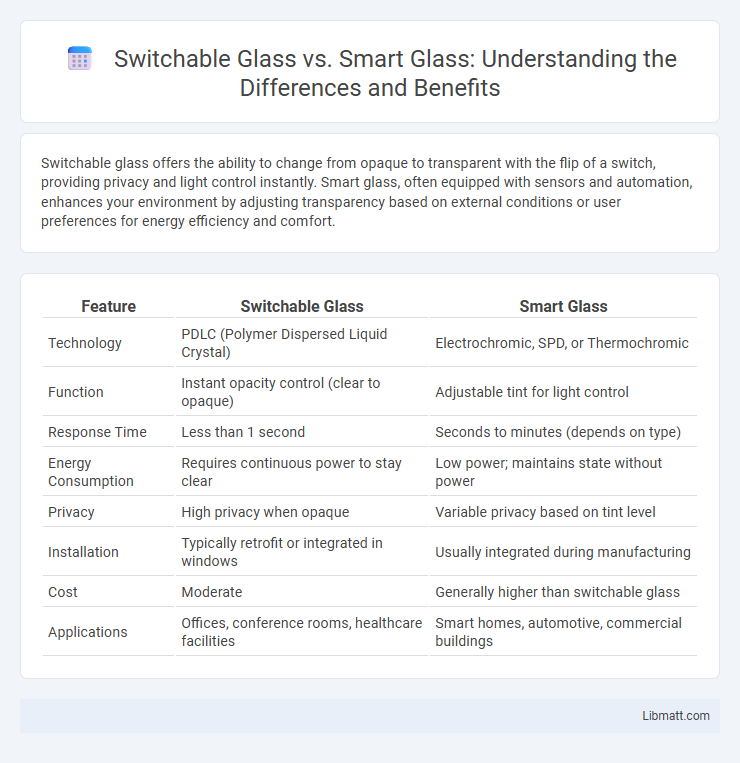Switchable glass offers the ability to change from opaque to transparent with the flip of a switch, providing privacy and light control instantly. Smart glass, often equipped with sensors and automation, enhances your environment by adjusting transparency based on external conditions or user preferences for energy efficiency and comfort.
Table of Comparison
| Feature | Switchable Glass | Smart Glass |
|---|---|---|
| Technology | PDLC (Polymer Dispersed Liquid Crystal) | Electrochromic, SPD, or Thermochromic |
| Function | Instant opacity control (clear to opaque) | Adjustable tint for light control |
| Response Time | Less than 1 second | Seconds to minutes (depends on type) |
| Energy Consumption | Requires continuous power to stay clear | Low power; maintains state without power |
| Privacy | High privacy when opaque | Variable privacy based on tint level |
| Installation | Typically retrofit or integrated in windows | Usually integrated during manufacturing |
| Cost | Moderate | Generally higher than switchable glass |
| Applications | Offices, conference rooms, healthcare facilities | Smart homes, automotive, commercial buildings |
Understanding Switchable Glass and Smart Glass
Switchable glass and smart glass both utilize advanced technology to control light transmission, enhancing privacy and energy efficiency in your space. Switchable glass typically uses polymer dispersed liquid crystal (PDLC) technology that changes opacity when an electric current is applied, while smart glass options may include electrochromic, thermochromic, or photochromic methods for dynamic tinting. Understanding their mechanisms helps you choose the ideal solution for privacy, light control, and sustainable design needs.
Key Differences Between Switchable Glass and Smart Glass
Switchable glass changes its transparency or opacity through an electric current, often using technologies like PDLC or SPD, allowing for instant privacy or light control. Smart glass encompasses a broader category of advanced materials, including switchable glass, electrochromic glass, and photochromic glass, offering variable tinting capabilities and energy efficiency. The key difference lies in switchable glass's binary state (clear or opaque) versus smart glass's dynamic modulation of light transmission and shading levels.
How Switchable Glass Works
Switchable glass operates by using a special liquid crystal or suspended particle technology embedded between glass layers that changes transparency when an electrical current is applied. When powered, the alignment of liquid crystals or particles shifts, allowing light to pass through and making the glass clear; when off, the glass becomes opaque for privacy. Your control over the electrical input enables seamless transitions between opaque and transparent states, enhancing both functionality and energy efficiency in various settings.
How Smart Glass Technology Operates
Smart glass technology operates by manipulating the properties of glass using embedded materials such as liquid crystals, suspended particles, or electrochromic coatings that respond to electrical signals. This allows the glass to switch between transparent, translucent, or opaque states, providing privacy, light control, and energy efficiency. Your choice between switchable glass and smart glass depends on the specific technology, speed of transition, and level of control required for your application.
Applications of Switchable Glass
Switchable glass finds extensive application in commercial buildings, enabling dynamic control of privacy and natural light, which reduces energy consumption and enhances occupant comfort. In healthcare facilities, it provides hygienic, easy-to-clean partitions that offer instant privacy without compromising light transmission. Automotive and aerospace sectors use switchable glass for glare reduction and customizable tint, improving safety and passenger experience.
Common Uses for Smart Glass
Smart glass is commonly used in commercial buildings, healthcare facilities, and automotive windows to provide privacy, control glare, and improve energy efficiency. Your office or home can benefit from smart glass technology by offering instant transparency adjustment, enhancing comfort and reducing the need for blinds or curtains. Unlike switchable glass, smart glass often integrates with automated systems for seamless operation and customization.
Benefits of Switchable Glass
Switchable glass offers enhanced privacy control by instantly changing from transparent to opaque with an electrical signal, reducing the need for blinds or curtains. It improves energy efficiency by controlling solar heat gain and glare, contributing to lower cooling costs in buildings. The customizable transparency also enhances aesthetic appeal and flexibility in interior design for both commercial and residential spaces.
Advantages of Smart Glass Installations
Smart glass installations offer enhanced energy efficiency through dynamic light and heat control, reducing reliance on artificial lighting and HVAC systems. They provide superior privacy options with instant opacity changes, improving comfort in residential and commercial spaces. Integration with building automation systems allows seamless user control and customization, optimizing both functionality and aesthetics in modern architectural designs.
Cost Comparison: Switchable Glass vs Smart Glass
Switchable glass generally offers a lower upfront cost compared to smart glass, making it a more budget-friendly option for projects requiring privacy or light control. Smart glass, which incorporates advanced technologies like electrochromic or thermochromic properties, tends to have higher installation and maintenance expenses due to its complex electronic components. Over time, smart glass may provide energy savings that offset its initial cost, but the initial investment remains significantly higher than traditional switchable glass.
Choosing the Right Glass Technology for Your Project
Switchable glass and smart glass both offer dynamic transparency control, but choosing the right technology depends on your project's specific needs and budget. Switchable glass primarily utilizes PDLC (polymer dispersed liquid crystal) technology to instantly change from opaque to clear with electrical input, ideal for privacy and energy efficiency in offices and healthcare. Smart glass incorporates various technologies such as electrochromic and thermochromic materials, enabling gradual tint adjustment for solar control and glare reduction, suitable for architectural facades and automotive applications.
switchable glass vs smart glass Infographic

 libmatt.com
libmatt.com